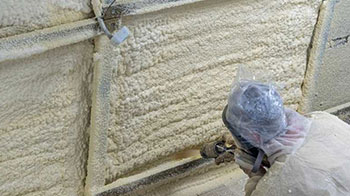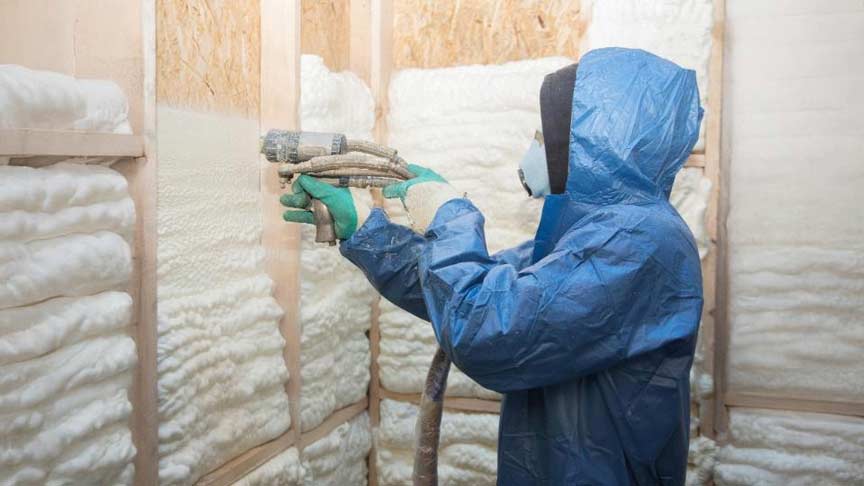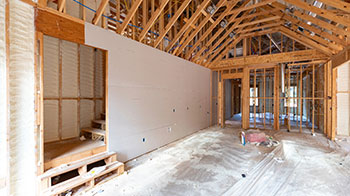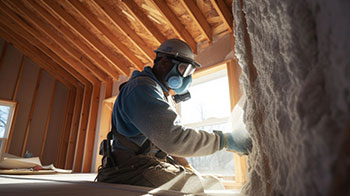In Maryland and Virginia, where our summers are hot and humid and our winters get chilly, spray foam insulation is becoming the go-to choice for homeowners and contractors. It helps keep your home comfortable year-round while cutting down on energy bills. With strong its insulating power, built-in air sealing, resistance to vapor and moisture, and even soundproofing benefits, spray foam offers a modern solution for today’s homes. This 2025 guide breaks down why it’s such a smart upgrade for our Mid-Atlantic climate.
Open-Cell vs. Closed-Cell: Two Foam Options
There are two main types of foam insulation: open-cell foam and closed-cell.
Open-Cell Foam
Open cell foam is a lighter weight foam that expands extensively to fill cavities, making it great for hard-to-reach areas and interior applications. It provides an R-value of R-3.5 to R-4 of insulation per inch and creates an effective seal against air infiltration and drafts. It’s vapor permeable and doesn’t provide a full moisture barrier, but its structure does absorb sound well. It’s typically more cost effective per inch of thickness compared to closed-cell foam and works well inside homes.
Closed Cell Foam
Closed cell foam is dense, rigid, and packs a punch with an R-value of R-6 to R-7 per inch, one of the highest you’ll find. It blocks vapor and moisture (when applied to a sufficient thickness of approximately 2+ inches), adds strength to walls and roofs, and is perfect for crawl spaces or basements. It’s a great option when you need a strong barrier in humid conditions or tight spaces. The solid cell structure makes it rigid, which helps support buildings during storms and high winds.
Choosing the Right Type
Both types expand to fill and insulate cracks and gaps and seal around wires and pipes, creating a strong thermal and air barrier. Closed cell foam, when applied thick enough, also acts as a vapor and moisture barrier, making it a great choice for our humid climate. Count on a professional installer to recommend the best type (or combo) of spray foam for your home’s specific needs.
Let’s explore some of the benefits of spray foam more in depth.
Energy Efficiency and Cost Savings
Spray foam forms a high R-value blanket of insulation that significantly reduces heat loss in winter and heat gain in summer. This keeps your home’s temperature more stable, helping your heating and cooling systems run less often. According to the EPA’s ENERGY STAR program, sealing air leaks and adding insulation to your home can cut your heating and cooling costs by an average of 15% (and total energy bills by 11%). With our ever-changing weather here in Maryland and Virginia, those savings add up quickly, especially if you’re upgrading an older, under-insulated home.
Air Sealing for Comfort (No More Drafts!)
The beauty of spray foam is that it doesn’t just insulate like traditional insulation, it seals air leaks too. With the Department of Energy reporting that air leaks account for 30% or more of our heating and cooling costs, that makes spray foam even more valuable.
Air sealing with spray foam fills the abundant cracks and voids so often found around lights, pipes, wires, chimneys, and attic hatches. And works to keep your conditioned air inside your home where it belongs. Spray foam expands into those small crevices to create a tight envelope that helps to eliminate drafts and cold spots. It also keeps out outdoor pollutants and humidity for better indoor air quality. For local homeowners living in older homes with drafty windows, attics, and crawl spaces, spray foam is especially valuable for increasing comfort, eliminating drafts and enjoying your home.
Moisture Control and Mold Prevention
As we’ve already stated and the weather reminds us every summer and winter, humidity is a big concern in our corner of the U.S. Thankfully, spray foam works to combat that moisture in the air. It helps keep surfaces warmer and drier, safeguard’s your home’s structure, improves durability and provides peace of mind for local homeowners living in our high-humidity regions. Each type of spray foam works differently:
Closed cell foam
Acts as vapor barrier at proper thickness
- Help to block moisture from passing through your walls or ceiling
- Helps prevent condensation inside wall cavities
- Helps prevent mold growth on wood framing
- Building experts note closed-cell foam offers some of the best moisture control
Open-cell foam
Contributes to moisture management
- Reduces air transport of water vapor
- Allows assemblies to “breathe” somewhat
- Helps stop air leakage that would carry moist air into your house
Sound Dampening for a Quieter Home
One hidden perk of open cell foam is noise reduction. It absorbs sound, reducing noise transmission through walls and floors. This helps quiet down outside noise from traffic and loud neighbors, as well as add privacy from room-to-room noise when used inside. It’s even been shown to provide similar acoustic performance as fiberglass. It’s an ideal way to add privacy and peace to your busy home.
A Smart Investment for Maryland & Virginia Homes

At Foam InSEALators, we install top quality spray foam products known for their high performance and reliability. Our skilled team members have been expertly installing foam insulation in the homes and buildings of our Maryland and Northern Virginia communities since 1994. Contact us today for your free estimate and home energy assessment. Let us help you experience the difference spray foam can make in your Maryland or Virginia home!
Works Cited
Energy Star. (n.d.). Methodology for Estimated Energy Savings. https://www.energystar.gov/saveathome/seal_insulate/methodology
Environmental Protection Agency. (n.d.). Seal and insulate with ENERGY STAR [Brochure]. U.S. EPA. Retrieved April 30, 2025, from https://archive.epa.gov/greenbuilding/web/pdf/seal_and_insulate.pdf
Frazier, R. S. (2017). The importance of residential and commercial building insulation (Fact Sheet BAE-1410). Oklahoma State University Cooperative Extension Service. Retrieved from https://extension.okstate.edu/fact-sheets/the-importance-of-residential-and-commercial-building-insulation.html
Johns Manville. (June 10, 2020). Spray-foam: open-cell vs closed-cell. https://www.jm.com/en/blog/2020/june/spray-foam–open-cell-vs–closed-cell/#:~:text=This%20microscopic%20difference%20in%20the,materials%20have%20decidedly%20different%20densities.
National Association of Home Builders Research Center. (1992). Testing and adoption of spray polyurethane foam for wood frame building construction. Upper Marlboro, MD: NAHB Research Center.
U.S. Department of Energy. (n.d.). Types of insulation. Energy Saver. Retrieved April 30, 2025, from https://www.energy.gov/energysaver/types-insulation


 Acts as vapor barrier at proper thickness
Acts as vapor barrier at proper thickness Contributes to moisture management
Contributes to moisture management